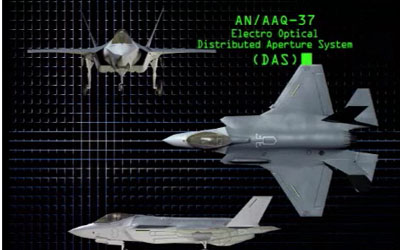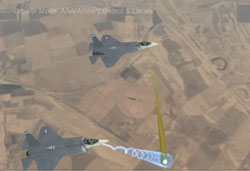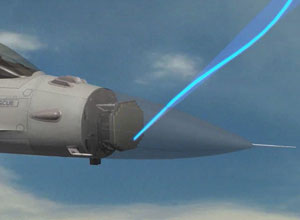An Interview With Chris Sheppard (Continued)
SLD sat down with Chris Sheppard, a manager of USAF programs for Northrop Grumman Corporation’s government relations group, to discuss the interaction between the F-16 and F-35 as the U.S. Air Force builds its capabilities into the 21st century. We asked Chris to share his personal experience as an F-16 pilot, his work on the F-35, and how the two compared. Chris works at the Fighter Demonstration Center in Arlington, Virginia, a facility shared by Lockheed Martin, Northrop Grumman, and Pratt and Whitney set up to showcase the Fifth Generation Fighter capabilities. Chris Sheppard has flown all F-16 blocks, “A through D,” he says, and has closely followed the fighter’s evolution from block to block in his current line of work at Northrop Grumman. A graduate of the Air Force Academy, Chris Sheppard is now an Air National Guard F-16 pilot and has flown F-16s operationally on active duty and with the reserve component, and participated in a number of combat exercises including Operation Northern Watch, Operation Southern Watch, and Operation Iraqi Freedom.
The F-35 is intended as the replacement for the F-16. This interview explores how the new fighter will execute future missions differently, as well as how the two fighters may work together during the transition. We also discussed with Chris Sheppard how customers can get greater connectivity between the two aircraft. Below is the second part of the interview.
***

SLD: You had referred to the F-35 pilot, as a tactical decision maker, but doesn’t the F-35 play a much more strategic role in the new paradigm?If you look at the Afghan operation it’s much closer to the Marine Corps concept of distributed operations, much like the Marines talk about the “strategic corporal.” In effect, some of the formations will be almost strategic in character in a decentralized operation.
Chris Sheppard: That is true. Fighter pilots are typically thought of as being tacticians in the Air Force construct of operations. Although they will continue to be front-line tacticians, having an asset like the F-35 provides the capability to have much more situational awareness and have a much more strategic impact on decisions made in the battle space. Part of the paradigm shift is viewing flying forces –in this case the fighter community- as part of the strategic, vice tactical, picture. This is similar to the concept you spoke of previously regarding the situations our ground forces find themselves in today’s fight – their decisions and subsequent actions can have significant strategic ramifications.
In the current fight, we’re continuing to appreciate the value of leadership and critical decision making at every level. The F-35’s ability to gather data and present it in a manner where decisions can be made puts this platform on a new step with regard to its strategic importance in terms of real-time decision making.
When time isn’t as critical, some decisions can be passed back to the rear echelons when there’s time to even more deliberately ascertain, analyze, and then proceed with the proper response. Many times decisions need to be made in real time- not only on the ground but in the air as well. The need to have that information there and to make the right decision is invaluable. One never knows. I’m sure the “strategic corporal” to whom you referred earlier didn’t anticipate the time he or she would be expected to make a decision that could have battlefield effects larger than they ever dreamed possible. But that’s what we’re facing now with this type of threat and I think we’ll continue to see in future world events.
SLD: Does stealth really change Concepts of Operations?
Chris Sheppard: Stealth provides the ability for true first-look, first-shot in a traditional kinetic effect, force-on-force type application. One has to ask: with the evolution of enemy weaponry and the projected evolution of threat aircraft by other countries building fifth-generation-like aircraft, will they be of the caliber of fifth generation aircraft that we see in the United States and with her allies? Perhaps not.
Will they be built in vast quantities? I think there’s general agreement that probably will be the case. Having the benefit of very low observable stealth on these aircraft does require that weapons be carried internally. This provides the aircraft the opportunity to have a much decreased chance of detection to not have to go into those force-on-force types of scenarios, depending on the situation.
Pilots have to be mindful of ground threats as well. With today’s precision-guided weapons, the aircraft is like a truck that’s carrying weapons into a combat envelope where they can be deployed, and then returned to base. That’s a fairly typical mission.
One benefit of the F-35 is the ability to reconfigure and carry even more weapons externally when the threat environment is assessed to be permissible to this type of configuration. This enables the benefit of internal and external stores to carry more ordnance to service more targets if called upon to do so. The F-35A can carry approximately 18,000 pounds of ordnance when fully loaded internally and externally, far exceeding the payload of the F-16 and F-18.

SLD: There’s a capability on the aircraft that may not be widely appreciated and that’s DAS. What does DAS do? And what does it do for your air-to-air combat and also what’s the potential for DAS to contribute to the Army and the Marine Corps on the ground?
Chris Sheppard: The Northrop Grumman Distributed Aperture System (DAS) is truly one of the game changing capabilities resident on the aircraft. We’re already seeing increased interest in its application on rotary wing aircraft, and on other assets for missions and roles such as missile defense, among others.
The Distributed Aperture System provides multiple capabilities to the aircraft. First, there’s no need to fly with night vision goggles, which we do now when conducting combat operations at night. The night vision goggles that we currently fly with are dependent upon the amplification of ambient light. In a sense, your night vision goggles are just another sensor. They don’t simply turn night into day and one must look and analyze before acting – much like a radar, much like a targeting pod.
The Distributed Aperture System (DAS) provides an EO/IR picture in a different spectrum than night vision goggles, such that it’s not dependent on ambient light, so now flying below cloud decks, and flying anywhere there’s an overcast sky, or where ambient light’s not present, is possible.
The second thing is its ability to detect missiles. There’s a lot of growth capability in the Distributed Aperture System. I think we’re only on the cusp of understanding what its true value will be to the war fighter. Its ability to detect and accurately locate firing points of missiles and anti-aircraft artillery is key to getting other sensors locked on to where that threat came from, so the appropriate action can be taken – whether it’s kinetic or non-kinetic.
DAS has a situational awareness mode that simultaneously tracks all aircraft within range, spherically about the F-35. This capability will have significant implications in air combat maneuvering, for launching off-boresight weapons, and for overall survivability.
There are also growth modes for the Distributed Aperture System which will significantly enhance the platform’s networking capability. DAS works in a spherical context and is always on, all the time, always detecting. Perhaps our biggest challenge is DAS taking in so much information that the next step is to figure out how to manage and distribute all the data it can provide.
SLD: One thing that’s not appreciated is how the F-35 can potentially reshape the next generation of UAV operations. In the manned-to-unmanned evolution, what do you think about the possibility of off-loading data to an unmanned flying data recovery system?
Chris Sheppard: There are multiple options. One of the consistent concerns of combatant commanders articulated over and over again is the need to hand off data in a usable format. It’s about turning data into actionable intelligence. The capability needed is well-articulated; our challenge is to devise the most efficient manner to manage the data and make the intelligence actionable.
SLD: So the F-35 can contribute by managing data choke points for leaders who have to make real-time decisions in a tight timeframe?
Chris Sheppard: The F-35 could aid by gathering and assimilating data from others in some circumstances, or acting as a data provider to other systems. If the objective is to get the data off board to preserve the processing power on the jet for other functions, it can be a data provider. Perhaps in other circumstances the best option is to utilize on-board fusion capacity, then relay. We’re now evolving into a system-of-systems construct, and we can readily see how such a “flying combat system” — when integrated with the ground forces — provides important new capabilities from which to develop the future of air as well as ground and sea operations.
SLD: Let’s turn to the transition from the F-16 to the F-35. As squadrons of F-35s are added, how will the F-16 mission evolve?
Chris Sheppard: We’ve already started to see the evolution in the concept of operations and concepts of employment. Fifth-generation fighters are working with fourth-generation fighters, not only from the U.S. perspective, but from a coalition perspective, in exercises throughout the world. The ability for the F-35 and the F-22 to provide the benefit of fused data discussed earlier in this conversation, and hand that off, whether via voice, data link or other methods, to other fighters is invaluable. Even after these fifth-generation fighters have gone into a highly contested threat area and expended all their ordinance, they’re still of tremendous value in coming back to act as battle space managers.
Looking at this from a battle management perspective, we may have a scenario where F-16s are utilized as a ‘bomb truck’ carrying weapons into a less contested battle space. The F-35 can track and identify potential targets from denied airspace, and signal back or provide awareness to legacy aircraft for follow on tactics. Our ‘bomb trucks’ may launch missiles from the less contested areas eliminating threats while the F-35 continues to conduct its operations in the anti-access battle space. This invites a whole new conversation on the next evolution of weapons for the F-16, F-15, or Eurofighter.

SLD: Northrop Grumman recently introduced the Scalable Agile Beam Radar (SABR), which promises to be an important enhancement for the F-16, both for the U.S. and potentially for allies. How does SABR contribute to the fourth to fifth generation fighter evolution?
Chris Sheppard: The entire aerospace and defense community will continue to raise the question: “What will become of the fourth-generation force structure, especially the great number of F-16s—both domestic and international?” We rely upon the F-16 for not only for overseas contingency operations, but also for mission of air sovereignty alert in the United States. We work very closely with allied nations flying similar platforms throughout the world.
Developing an affordable sensor for legacy aircraft that doesn’t require any modifications to the outer mold lines of the aircraft and which can be put into the aircraft on the flight line without having to go through a depot modification and lose aircraft availability is tremendous.
In terms of capability, Northrop Grumman has leveraged its core competence in Active Electronically Scanned Array radars to provide the highest possible commonality in keeping with the objectives I just stated. This will give the F-16 enhanced capability, relevance, and much improved sustainment. An F-16 AESA system like SABR will provide much greater situational awareness; more precise, multiple target tracking for both air and ground targets; and a very high resolution synthetic aperture radar map capability. Some capabilities are ported from the F-35 – like much greater electronic protection. The bottom line is it gives the F-16 aircraft much greater operational availability and relevance.
The real value that comes out of all this is the leveraging of technology. The ability to leverage investments in fifth-generation fighter technology back into fourth-generation fighters keeps them relevant with sensor enhancements.
It’s not about turning fourth-generation fighters into fifth-gen fighters; that’s not possible. In order to add value and keep them relevant you have to explore doing things like sensor enhancements, i.e. putting active electronically scanned arrays and other sensors on board, not in a very low observable context, but in support of the total force structure to keep those aircraft relevant. It’s generally accepted that we’re going to continue to need F-16s in our force structure; all invested in our fighter force structure are going to have to make some tough decisions with regard to how our future force will be balanced and what’s a right mix of fifth-generation versus fourth-generation fighters.
———-
*** Posted on March 31st 2010



